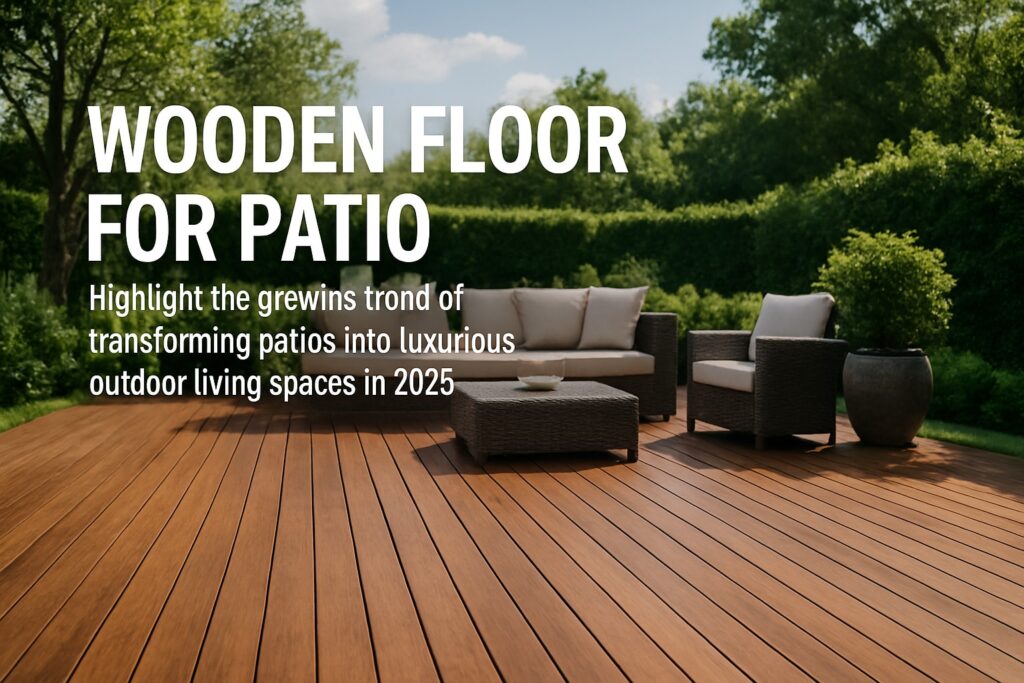In 2025, homeowners are redefining outdoor living by transforming patios into luxurious extensions of their homes. The timeless charm and flexibility of wood make it the preferred choice for creating inviting, functional spaces.
Selecting the right wooden floor for patio not only enhances comfort and visual appeal but also increases your property’s market value. Wood’s warmth and adaptability suit any style, from sleek modern layouts to cozy rustic retreats.
This essential guide will walk you through everything you need to know about wooden floor for patio projects in 2025. You will discover the best wood types, current design trends, practical installation steps, maintenance routines, sustainable options, and expert advice.
Whether you are planning a fresh installation or an upgrade, this article is your comprehensive resource for crafting a stunning and durable outdoor space.
Why Choose Wooden Flooring for Your Patio in 2025?
Transforming your outdoor area starts with the right foundation. A wooden floor for patio spaces brings a unique combination of elegance, comfort, and value that stands out among material choices for 2025. Let’s explore why homeowners and designers continue to make wood their top pick for patios.
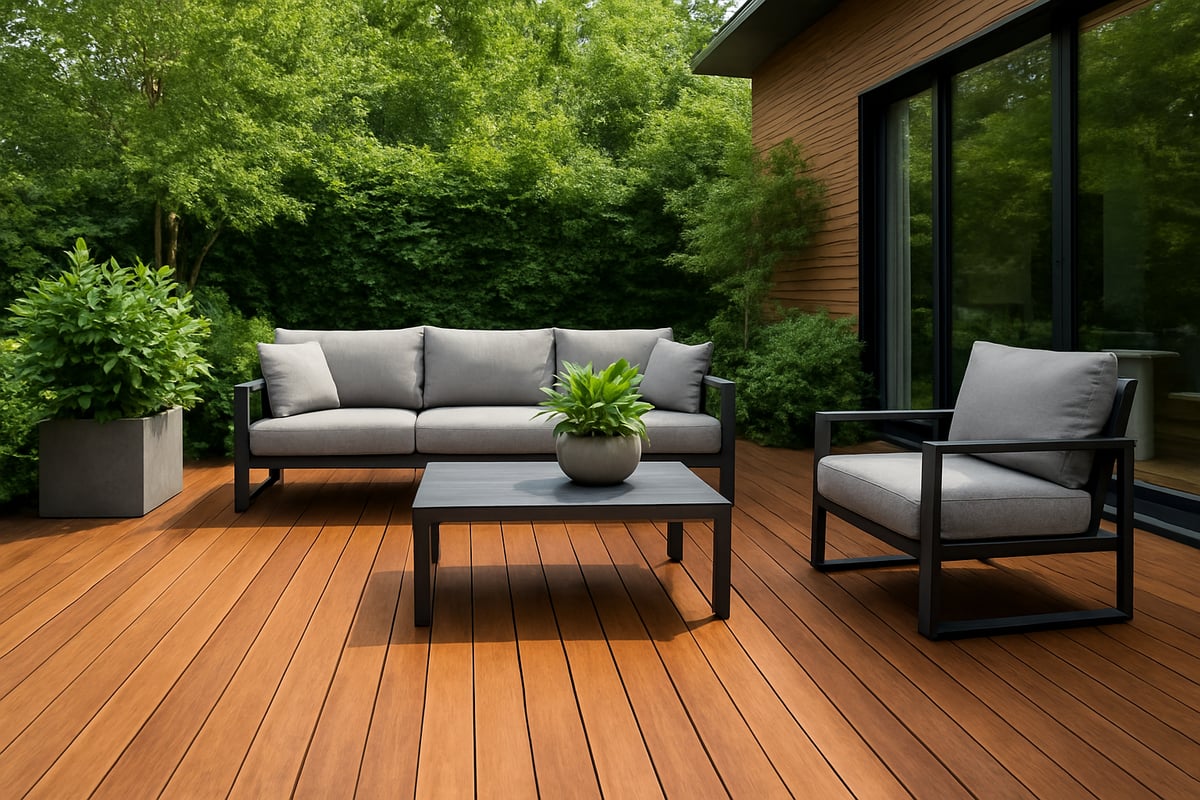
Natural Beauty and Timeless Appeal
A wooden floor for patio settings radiates warmth and sophistication that other surfaces often lack. The natural grain and color variations of wood create visual interest, blending seamlessly with both modern and rustic architecture. Whether you are designing a sleek urban space or a cozy backyard retreat, wood adapts to your vision. Imagine a contemporary patio with wide-plank ash flooring or a classic rustic deck with weathered cedar—both timeless, both inviting.
Durability and Performance Improvements
Recent advancements in wood treatment have made the wooden floor for patio installations more resilient than ever. Treated hardwoods, such as Ipe and Cumaru, can withstand harsh weather, resist rot, and outlast many other materials. Properly installed and maintained, these floors can remain beautiful for 20 years or more. Enhanced finishes now protect against UV rays and moisture, ensuring your investment stands up to the elements.
Comfort and Functionality
Unlike concrete or stone, a wooden floor for patio use feels gentle underfoot and maintains a comfortable temperature, even during peak summer. Textured finishes offer improved slip resistance, adding safety for families and guests. The wood’s slight give also makes extended periods of standing or walking more comfortable, turning your patio into a true extension of your indoor living space.
Versatility in Design
Wood’s flexibility opens up a world of creative possibilities. You can select from classic planks, geometric herringbone, or modular tiles to customize your layout. Wood pairs effortlessly with planters, lighting, and outdoor kitchens, adapting to every design need. For those seeking inspiration or technical details on layout options, the Wooden Deck Tile Brochure is an excellent resource for exploring versatile solutions.
Sustainability and Eco-Conscious Choices
A wooden floor for patio projects in 2025 often features certified or reclaimed wood, supporting sustainability goals. FSC-certified lumber ensures responsible forestry, while reclaimed timbers give new life to old materials. Compared to concrete or composite, wood’s carbon footprint is lower, making it a preferred choice for eco-conscious homeowners. Recent studies show that 60% of homeowners now prioritize sustainable options when renovating outdoor spaces.
Value Addition and ROI
Investing in a wooden floor for patio areas not only boosts curb appeal but also adds significant value to your property. According to industry reports, outdoor upgrades can deliver up to 80% return on investment. Wood’s natural look enhances the overall marketability of a home, making it a smart choice for those thinking about future resale. The combination of beauty and function is hard to beat.
Common Misconceptions About Wooden Patio Floors
Some believe a wooden floor for patio environments is high-maintenance or not durable outdoors. In reality, modern treatments and sealants have drastically simplified upkeep and improved performance. With the right care, today’s wooden patio floors are engineered to last, dispelling outdated myths and offering a practical, long-lasting solution for outdoor living.
Choosing the Best Wood for Patio Flooring in 2025
Selecting the right wooden floor for patio projects in 2025 is a crucial decision that impacts durability, aesthetics, and long-term value. The variety of materials available today can make the process overwhelming, but understanding the unique benefits of each option will help you make an informed choice for your outdoor space.
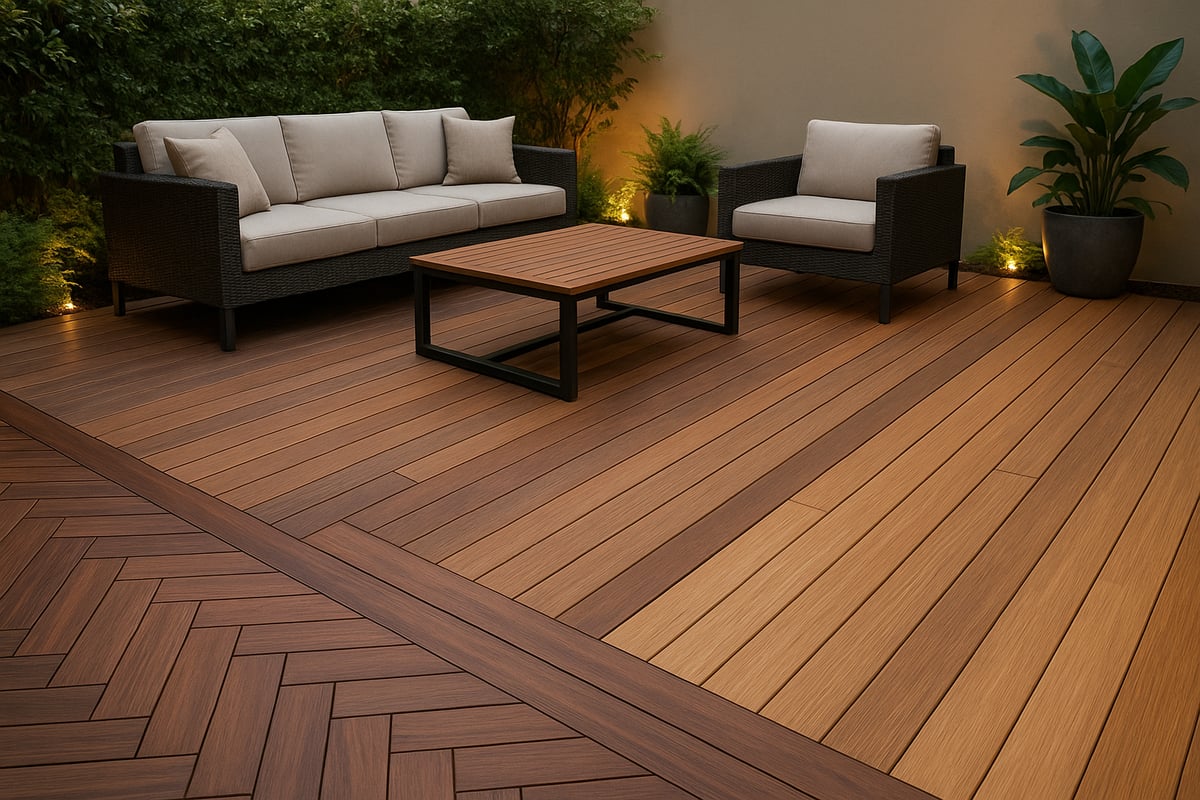
Hardwood vs. Softwood: Pros, Cons, and Best Uses
When choosing a wooden floor for patio settings, understanding the differences between hardwood and softwood is essential. Hardwoods like Ipe, Teak, Cumaru, and Mahogany are renowned for their density, resistance to rot, and exceptional longevity. These species are ideal for high-traffic patios that demand durability and minimal maintenance.
Softwoods, such as Cedar, Redwood, and Pressure-treated Pine, offer a lighter feel and are often more affordable. While softwoods can be less resistant to wear, modern treatments have improved their performance for outdoor use. Softwoods suit patios where budget and a classic look are priorities, but they may require more frequent sealing to maintain their appearance.
Engineered and Composite Wood Alternatives
For homeowners seeking a low-maintenance wooden floor for patio environments, engineered and composite options are increasingly popular. Composite deck tiles and engineered wood products combine wood fibers with polymers, resulting in enhanced weather resistance and color retention.
These alternatives mimic natural wood but are less prone to warping, splintering, or fading. However, they can retain more heat in direct sunlight and sometimes lack the authentic texture of real wood. Composite options are ideal for patios exposed to harsh climates or where ease of care is a top priority.
Key Selection Criteria
Several factors should guide your wooden floor for patio decision in 2025. Climate plays a significant role—moisture, freeze-thaw cycles, and UV exposure can affect wood performance. Opt for species suited to your region's conditions.
Budget is another important consideration. While hardwoods may have a higher upfront cost, their longevity often delivers better long-term value. Always check local availability and ensure your supplier sources responsibly. Consulting with professionals can help match your goals and constraints to the right material.
Popular Wood Species for Patios in 2025
The leading choices for a wooden floor for patio projects this year include Ipe, thermally modified ash, and bamboo. Ipe, an ultra-dense hardwood, stands out for its resistance to rot and insects. Thermally modified ash offers a sustainable and durable alternative, while engineered bamboo appeals to eco-conscious homeowners.
When considering Ipe, explore its versatility and performance through resources like the Ipe Paver Outdoor Flooring guide, which details its premium qualities and installation options. These species vary in price, but all deliver excellent durability and aesthetics.
Finish and Color Trends
Finish and color choices can transform the look of any wooden floor for patio areas. The 2025 trend leans toward natural matte finishes, subtle grey-washed tones, and bold stains that complement modern outdoor designs. Matching wood tones to your exterior décor creates a cohesive flow between indoor and outdoor living spaces.
Matte finishes highlight the natural grain, while grey washes evoke a weathered, coastal feel. Bold stains add personality for homeowners seeking a statement patio. Always choose outdoor-rated finishes to ensure lasting beauty.
Sustainability and Certifications
As sustainability takes center stage, selecting certified wood for your wooden floor for patio is vital. Look for FSC or PEFC labels to ensure responsible forestry practices. Reclaimed wood is another eco-friendly choice, offering unique character and reduced environmental impact.
Authenticity matters, so verify the source of reclaimed materials and check for proper treatment against pests and decay. Eco-conscious buyers will appreciate these options, knowing their patio upgrade supports sustainable living.
Avoiding Common Pitfalls
Avoiding mistakes when installing a wooden floor for patio spaces will save time and money. Steer clear of untreated or low-quality wood, which can lead to premature deterioration. Always prioritize professional advice and reputable suppliers to ensure your investment stands the test of time.
Proper installation, regular maintenance, and attention to finishes are key to enjoying a long-lasting, beautiful patio floor. With the right approach, your wooden patio will offer years of comfort and style.
Planning and Designing Your Wooden Patio Floor
Transforming your outdoor space with a wooden floor for patio begins long before installation. Careful planning ensures your investment delivers comfort, beauty, and lasting value. Each decision, from structure assessment to design inspiration, shapes the success of your project. Let’s break down the essential steps for planning the ideal wooden floor for patio in 2025.
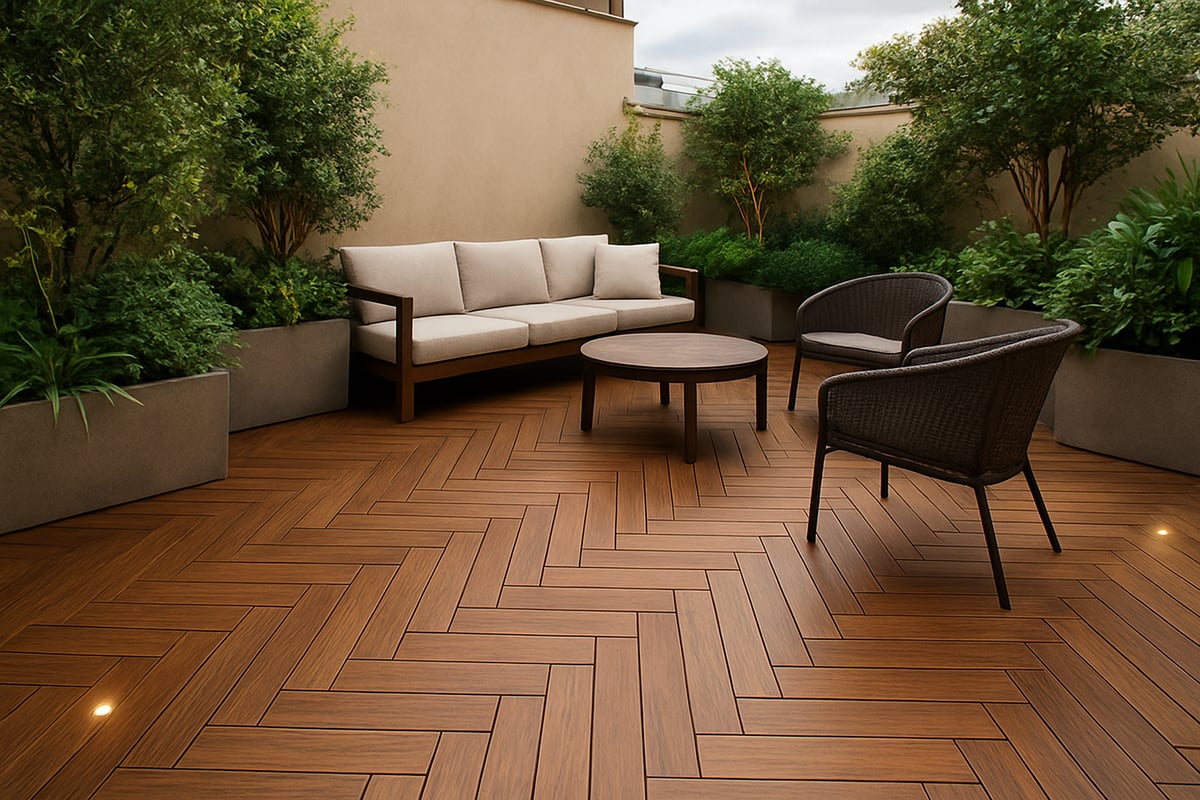
Assessing Patio Structure and Suitability
Start by evaluating the foundation where your wooden floor for patio will be installed. Check if the subfloor can support the weight of wood, outdoor furniture, and foot traffic. Drainage is critical for longevity, so ensure water flows away from the surface. If your patio is uneven or sloped, plan for leveling solutions or adjustable pedestals. For rooftop patios, proper waterproofing is essential to prevent leaks and damage to underlying structures.
Layout and Pattern Options
The layout of your wooden floor for patio influences both aesthetics and function. Choices like traditional plank, diagonal, parquet, or modular tiles can make small spaces appear larger or add unique character. Patterns such as herringbone or chevron offer a modern twist, while straight planks suit classic settings. When selecting a pattern, consider how it complements your home’s architecture and outdoor features. Modular tiles allow for quick updates and creative arrangements.
Integrating with Existing Outdoor Features
Design your wooden floor for patio to harmonize with landscaping, pools, or outdoor kitchens. Match wood tones to existing elements for a cohesive look. Plan transitions between the patio and garden or pool area for safety and accessibility. Incorporate built-in planters, seating, or lighting to enhance function and ambiance. Prioritize slip-resistant finishes for areas near water, and ensure pathways remain clear and easy to navigate.
Budgeting and Cost Breakdown
Budgeting for a wooden floor for patio means considering more than just the price of wood. Factor in labor, underlayment, fasteners, and sealants. Here’s a quick breakdown:
| Item | Average Cost (per sq ft) |
|---|---|
| Wood Materials | $8–$25 |
| Labor | $7–$15 |
| Accessories | $2–$5 |
| Total Installed | $15–$40 |
Remember to include hidden costs such as drainage solutions or custom cutting. Planning ahead helps you avoid surprises and ensures your project stays within budget.
Permits and Building Codes
Before installing a wooden floor for patio, check local building codes and permit requirements. Some areas have strict regulations, especially for rooftop or multi-family buildings. If you live in a condo or HOA community, review their rules on outdoor renovations. Complying with permits and codes prevents delays and costly modifications down the line. Consult with professionals or local authorities to confirm you meet all standards.
Design Inspiration and Case Studies
Explore current trends to spark ideas for your wooden floor for patio. Multi-use zones, built-in seating, and integrated lighting are popular features in 2025. Urban rooftop patios often use wood to create a warm, inviting retreat above the city. For more creative layouts and style ideas, browse Outdoor Floor Design Ideas to see real-world examples and innovative solutions for various spaces.
Mistakes to Avoid in Planning
Avoid common pitfalls when planning a wooden floor for patio. Neglecting drainage can lead to water damage and shortened lifespan. Skipping expansion gaps may result in warping as wood expands and contracts with weather changes. Ensure proper ventilation beneath the wood to prevent mold and rot. Thorough planning, professional advice, and attention to these details set the stage for a beautiful, durable patio floor.
Step-by-Step Guide: Installing Wooden Flooring on Your Patio
Transforming your patio with a wooden floor for patio installation is both rewarding and achievable when you follow a clear, structured process. Whether you are a DIY enthusiast or planning to hire a professional, understanding each step ensures your outdoor space is not only beautiful but also built to last.
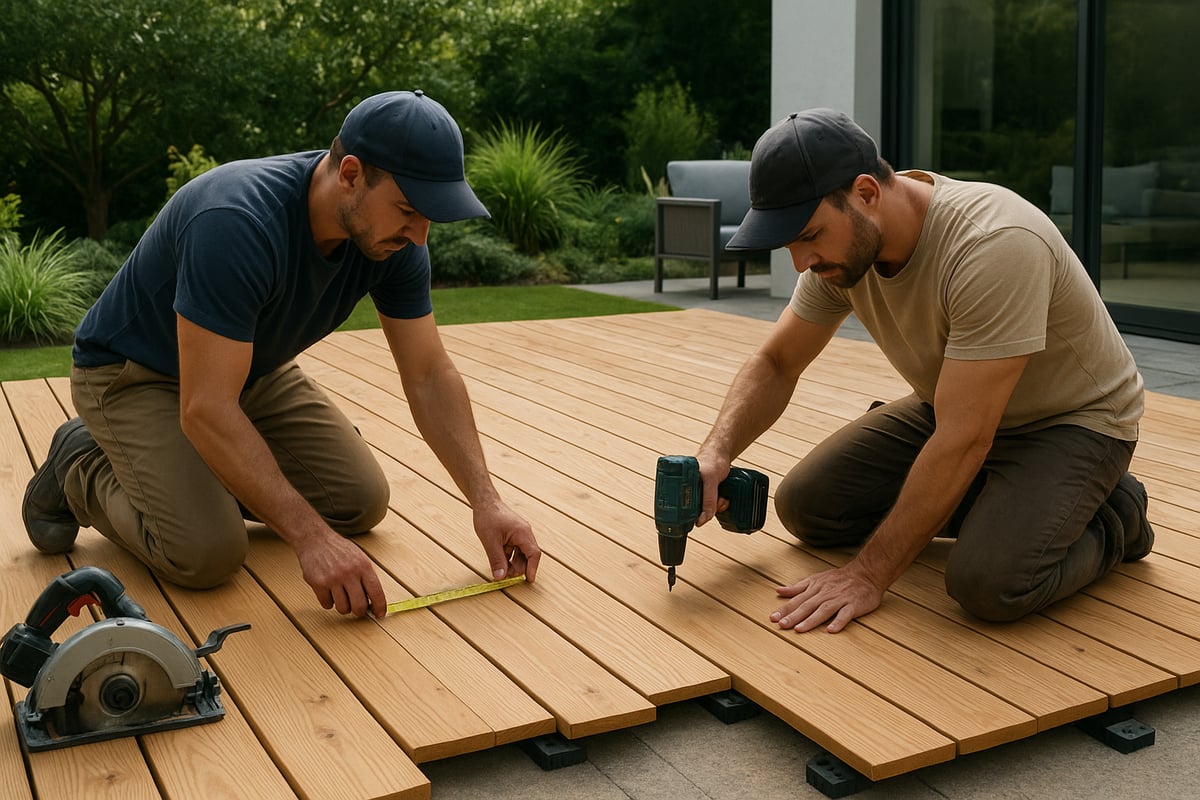
Step 1: Preparation and Planning
Start your wooden floor for patio project by measuring the entire area carefully. Accurate dimensions are crucial for ordering the right amount of material and minimizing waste. Next, gather all necessary tools: tape measure, saw, drill, level, spacers, fasteners, and protective gear.
Check the weather forecast before beginning, as moisture can affect both wood and adhesives. Consider the type of wood or composite you will use, factoring in climate, style, and maintenance needs. Planning ahead ensures your patio flooring project runs smoothly from start to finish.
Step 2: Preparing the Substrate
A stable, level substrate is the foundation of any wooden floor for patio. Begin by thoroughly cleaning the surface, removing debris, dirt, and any existing coatings. Address any uneven spots by filling low areas or sanding down high points.
For patios with existing concrete or tile, check for cracks or moisture issues. Apply a waterproof membrane to protect the wood from ground dampness. In some cases, installing an underlayment or adjustable pedestals is recommended to promote drainage and ventilation, especially for rooftop patios.
Step 3: Laying Out the First Row
Laying the first row correctly is vital for a successful wooden floor for patio installation. Use a chalk line or straight edge to mark your starting point, ensuring the boards or tiles run parallel to the main walls or desired focal point.
Place spacers between the wood and fixed structures to allow for natural expansion and contraction. Double check alignment before securing the boards, as any mistakes in this row will affect the rest of the installation. Take your time—precision here sets the tone for the entire patio.
Step 4: Securing the Boards or Tiles
Securing your wooden floor for patio depends on the chosen material and system. For traditional planks, use corrosion-resistant screws or hidden fasteners to attach boards securely. Modular or floating systems may use clips or interlocking mechanisms for a seamless appearance.
If you are considering composite deck tiles, review the Composite Deck Tiles Guide for best practices on installation and maintenance. Always follow manufacturer instructions for fastener spacing and placement to ensure durability and safety.
Step 5: Cutting and Fitting Edges
Achieving a polished look for your wooden floor for patio requires precise cutting and fitting, especially around corners, posts, or obstacles. Use a circular saw or jigsaw to trim boards as needed, measuring twice before each cut.
Maintain proper ventilation by leaving a perimeter gap between the wood and any permanent structure. This gap allows for air flow and water drainage, preventing issues like warping or rot over time. Double check all edge pieces for a snug, secure fit.
Step 6: Applying Finishes and Sealants
Finishing your wooden floor for patio with the right products protects it from the elements and enhances its appearance. Choose an outdoor-rated sealer, stain, or oil that suits your wood type and local climate.
Apply finishes evenly, following the grain for a natural look. Allow adequate drying or curing time as recommended by the product manufacturer before moving furniture or using the patio. Regular finishing extends the longevity and beauty of your outdoor flooring.
Step 7: Final Inspection and Safety Checks
After installation, inspect your wooden floor for patio thoroughly. Look for loose boards, exposed fasteners, or sharp edges that could pose safety risks. Walk the surface to check for stability and evenness.
Verify that your installation meets local building codes and any HOA requirements. Address any issues promptly to ensure a safe, long-lasting result. Remember, a well-executed patio floor not only looks great but also adds lasting value to your home.
DIY vs. Professional Installation
Deciding between DIY and professional installation for your wooden floor for patio depends on skill level, project complexity, and budget. DIY offers cost savings and satisfaction, but professionals bring expertise and efficiency, especially for large or intricate patios. For best results, consult with specialists if unsure about any step.
Maintenance and Care for Wooden Patio Floors
Keeping your wooden floor for patio in top condition requires a blend of regular cleaning, seasonal inspections, smart protection strategies, and eco-friendly products. With the right care, you can enjoy a beautiful, safe, and long-lasting outdoor space that stands up to the elements and daily use.
Routine Cleaning and Upkeep
Consistent cleaning is essential for preserving your wooden floor for patio. Start by sweeping the surface weekly to remove dirt, leaves, and debris that can trap moisture.
- Use a soft-bristle broom or leaf blower.
- For deeper cleaning, wash with a mild soap and water solution.
- Rinse thoroughly and let the surface dry completely.
Prompt removal of spills helps prevent stains and discoloration.
Annual Inspection and Maintenance Tasks
Every year, take time to inspect your wooden floor for patio for signs of wear or damage. Look for:
- Loose boards or fasteners
- Splintered or cracked wood
- Areas of rot or mold
Address minor issues early to prevent larger repairs. Reapply a high-quality sealant or stain every one to three years, depending on exposure and product recommendations.
Weather Protection Strategies
Protecting your wooden floor for patio from weather extremes is vital. During winter or heavy rain, consider using breathable patio covers or furniture mats in high-traffic zones.
- Shield wood from direct sunlight to reduce fading.
- Move planters and rugs regularly to avoid moisture buildup.
- Elevate furniture with pads to prevent scratching and water marks.
These steps maintain both appearance and structural integrity.
Repairing Common Issues
Over time, even the best wooden floor for patio may develop minor problems. Address these quickly to extend lifespan.
- Fill small cracks with exterior wood filler.
- Sand and refinish rough patches to avoid splinters.
- Replace severely damaged boards to maintain safety and aesthetics.
Regular attention ensures your patio floor remains safe and attractive.
Enhancing Longevity
You can maximize the life of your wooden floor for patio with a few proactive measures. Use furniture pads to prevent dents, and oil or seal the surface as recommended by the manufacturer. Ensure proper airflow under decking to minimize moisture.
According to 5 Outdoor Flooring Trends Defining 2025, modern maintenance products and smart design choices are making it easier to keep wood patio floors looking new.
Troubleshooting and FAQs
Common concerns include slippery surfaces, fading, or pest issues. For slippery areas, opt for textured finishes or add anti-slip treatments. To prevent fading, reapply UV-resistant sealers. If pests appear, use targeted, wood-safe treatments.
If you encounter persistent problems, consult a professional for specialized advice or repairs.
Eco-Friendly Maintenance Products
Sustainability matters when caring for a wooden floor for patio. Choose low-VOC sealers and biodegradable cleaners to protect your family and the environment.
- Look for products certified by reputable eco-labels.
- Use natural oils when possible for a beautiful, breathable finish.
Staying informed about emerging patio flooring trends in the United States in 2025 will help you select the most responsible maintenance solutions available.
Trends and Innovations in Wooden Patio Flooring for 2025
The landscape of outdoor design is rapidly evolving, with the wooden floor for patio taking center stage in 2025. Homeowners and designers are embracing cutting-edge solutions that blend tradition with technology, sustainability, and style. Let’s explore the trends and innovations redefining the modern patio experience.
Smart and Modular Flooring Systems
Modular deck tiles are transforming how homeowners approach the wooden floor for patio projects. These systems offer quick installation, flexibility, and easy replacement, making them ideal for changing layouts or seasonal updates. Some modular options include integrated smart lighting or heating, merging comfort with cutting-edge convenience.
Innovations like hidden locking mechanisms and water-draining bases further enhance durability and user experience. To stay current with these advancements, review the Trends to Watch in Decking + Outdoor Living for a comprehensive look at evolving modular technologies.
Eco-Conscious Materials and Finishes
Sustainability is a driving force behind the latest wooden floor for patio trends. Thermally modified woods, recycled timber, and bamboo composites are gaining traction for their reduced environmental impact and impressive durability. Non-toxic, long-lasting finishes are now standard, protecting both the wood and the environment.
Homeowners are seeking options certified by organizations like FSC and PEFC. These choices ensure responsible forestry practices and add to the appeal of eco-friendly patios. Expect natural matte and weathered finishes to dominate the aesthetic landscape this year.
Customization and Personalization
Personal expression is a top priority for patio design in 2025. The wooden floor for patio is no longer a one-size-fits-all solution. Instead, custom patterns like chevron, herringbone, or intricate inlays offer unique visual interest and allow homeowners to reflect their style.
Mixed-material designs, such as combining wood with stone or metal, are also trending. These personalized touches create patios that are truly one-of-a-kind and serve as an extension of indoor living areas.
Technology in Maintenance
Smart technology is simplifying the upkeep of the wooden floor for patio. Moisture sensors connected to mobile apps can monitor wood conditions in real time, alerting owners to potential issues before they escalate. Automated cleaning tools are emerging, reducing manual labor and extending the lifespan of outdoor wood floors.
Predictive maintenance is another exciting development, with systems that analyze usage patterns and climate data to recommend timely care. These innovations ensure that patio floors remain both beautiful and functional year-round.
Outdoor Living Integration
A seamless connection between indoor and outdoor spaces is a hallmark of 2025 design. The wooden floor for patio now often features built-in planters, benches, and fire features, supporting multi-use zones for relaxation, dining, and entertainment.
Transitions from interior flooring to patio decking are smoother, with matching tones and finishes. This integration creates a cohesive look, blurring boundaries and enhancing the overall living experience.
Market Data and Consumer Preferences
Recent data shows that 72% of homeowners plan to upgrade their outdoor flooring in 2025, with the wooden floor for patio remaining a top choice. The popularity of natural wood aesthetics continues to outpace composite alternatives, as consumers seek authenticity and warmth.
For a deeper dive into these statistics and how patios are shaping home design, consult the Outdoor Patio Design Statistics and Trends for 2025.
Future Outlook
Looking ahead, expect the wooden floor for patio to further embrace sustainability, technology, and personalization. New wood species and eco-friendly treatments will enter the market, while design standards will continue to prioritize durability and flexibility.
As innovation accelerates, outdoor flooring will become an even more integral part of home value and lifestyle, ensuring that patios remain both stylish and sustainable for years to come.

